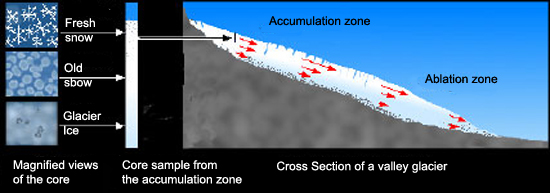
Courtesy of Rocky Mountain National Park
Glaciers are sensitive indicators of modern climate change because they respond to both temperature and precipitation:
- Precipitation: At its highest elevations, a glacier gains new snow each year in its accumulation zone. Over time, this snow becomes glacier ice.
- Temperature: In its lower reaches, a glacier loses mass as all of the winter snow and some of the glacier ice itself melts in the ablation zone.
Between a glacier's accumulation zone and its ablation zone is a thin area where only the amount of mass gained as snow melts away each year. This is known as the equilibrium line. Scientists often assess changes in the altitude of a glacier's equilibrium line to understand its health.
Whether it is advancing or retreating, every glacier flows downslope, moving ice from its accumulation zone to its ablation zone:
- If more mass is added as new snow in a glacier’s accumulation zone than is lost in its ablation zone, the glacier will advance.
- If more mass is melted from a glacier’s ablation zone than is added as new snow in its accumulation zone, the glacier will retreat.
For an example of how temperature and precipitation may affect glacial advance and retreat in our parks, visit Olympic National Park's glacier mass balance simulation.

1883 Photo: USGS Photo/Israel Russell 2015 Photo: NPS Photo/Keenan Takahashi
Today, many park glaciers are retreating as average temperatures increase and more precipitation falls as rain instead of snow.
To learn more about glaciers, glacier features, and glacial landforms, see the Glaciers & Glacial Landforms page.
Last updated: February 9, 2018
